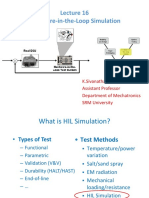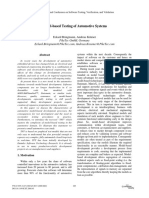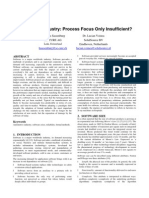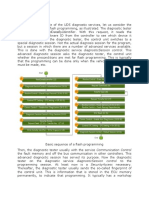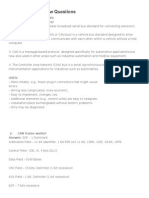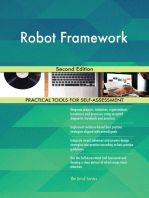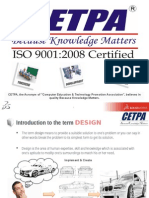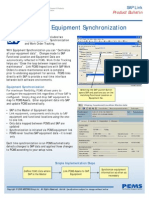2011 - A HiL Test Bench For Verification and Validation Purposes of Model-Based Developed Applications Using Simulink and OPC DA Technology PDF
Uploaded by
limakm2011 - A HiL Test Bench For Verification and Validation Purposes of Model-Based Developed Applications Using Simulink and OPC DA Technology PDF
Uploaded by
limakmA HiL Test Bench for Verification and Validation Purposes of Model-Based
Developed Applications Using Simulink
and OPC DA Technology
W.Chaaban
1
, M. Schwarz
1
, B. Batchuluun
1
, H. Sheng
1
and J. Brcsk
1
1
University of Kassel, Willhelmshher Allee 73, Germany
walid.chaaban@uni-kassel.de, m.schwarz @uni-kassel.de,
batsuren@uni-kassel.de, hsheng@uni-kassel.de
Abstract
This paper deals with the development procedures of a HiL
(Hardware-in-the-Loop) test bench for verification and
validation purposes of embedded application software
developed using MBD (Model Based Design) engineering
methodology. The testing environment have been mainly
developed for PLC (Programmable Logic Controller)
applications using Matlab
/Simulink
as a simulation
environment and the OPC DA (OLE for Process Control
Data Access) specification as communication interface for
data interchange with the OPC compliant (set as working
condition) target hardware. The main focus of this work was
to offer a tool or an instrument to end user or test engineer
that helps testing auto- generated embedded software while
running on target system and making decision and
statements about correct functionality and performance with
regard to main requirements in order to validate the
intended mission of the application aimed to reach.
1. Introduction
One of the big challenges of embedded application industries
nowadays is to launch superior quality products at lower cost for
sale on the market as fast as possible or in a short TTM. TTM
stands for Time-to-Market and represents the length of time it
takes since the idea of a product has been conceived until the
product has been available for sale. This period of time
represents a crucial factor and plays an important role in
industries due to the big competition between the market leaders
and taking into account that products are outmoded quickly and
have to be updated and extended as fast as possible in order to
meet market needs. The more complex and various are the
embedded activities intended to achieve, the more complex, time
consuming and error- prone is the belonging hand-written
embedded software where was the necessity to invent a new
engineering methodology to overcome all facing problems and
obstacles. MBD (Model Based Design) is the new trend and has
been increasingly used and gaining popularity in the last years in
many industrial sectors (such as aircraft, automation and
automotive applications etc), due to the big set of benefits and
advantages it provides for both sides manufacturers and end
consumers. Some of the benefits are listed in the following [1]:
Reduced time to market (faster development)
Detection and elimination of software bugs and errors in
early development stages (quality improvement)
Producing superior quality products at lower cost
Flexibility concerning updates and last minute changes
The model-based design paradigm is significantly different
from conventional design methodology. The central component
or starting point of a model based developed application is a
system model (simulation model), where designers or
developers model the control algorithm or functional
characteristics of the intended application as interconnected
function blocks provided by the library of the used modelling
tool, e.g. Simulink
(graphical programming language from
MathWorks
). After model development, simulation in the
virtual environment (MiL: Model-in-the-Loop) shows whether
the model works correctly with regard to given requirment
specifications. In case of requirements fullfillment an
automated code generation according to the hardware target can
be started in order to implement the modelled application in an
embedded code for hardware deployment, e.g. embedded C
code, using commercial autocoders (automatic code generator),
e.g. RTW Embedded Coder (RTW stands Real Time Workshop)
from MathWorks
. This feature lying in the ability of
automatically generating large amounts of code lines at one
button touch and in a very small time intervall appears to be one
of the main reasons for MBDs growth in popularity. This step
reduces radically time taken for code implementation in case of
hand-written code used in tradional design methodology and
avoids manually coded errors and bugs. The next step consists
of software testing, and verification which is not sufficiant for
validation since the developed software will be deployed on a
target hardware. This is why a Hardware-in-the-Loop (shortened
HiL) simulation has to be performed in which time behaviour
and hardware influences on the developed software can be tested
before any integration or system test are performed. The
different steps of the life cycle of the MBD engineering
methodology is represented in the V- Diagramm depicted in
Fig. 1 [2].
Modeling and
Simulation
Rapid Prototyping
Auto- Code Generation
HiL Test
Integration and Test
Fig. 1. MBD life cycle (V - Diagramm )
ELECO 2011 7th International Conference on Electrical and Electronics Engineering, 1-4 December, Bursa, TURKEY
46
This paper is a demonstration on how a HiL test environment
has been developed for validation purposes using Simulink as a
development and simulation environment and OPC DA
technology as a communication interface for interaction and
data interchange with OPC DA compliant target hardware
(mainly PLC). Development and tests have been made using
HIMA PLCs product family (new generation of HIMatrix and
the HIMax systems) as hardware, which can be operated and
programmed with the SILworX PADT (Programming and
Debugging Tool Product of the company HIMA). The rest of
the paper is structured as follows. Section 2 deals with the
different testing approaches accompanied with the different
development phases of the MBD life cycle. Section 3 gives a
short overview to the development environment and the
different software interfaces and tools used during development.
Section 4 deals with the focus of this work and the building
procedure of the HiL test bench. In section 5 performance
analysis and evaluation of the tool are discussed by means of a
simple example. Concluding remarks about the tool are
explained in part 6 followed by future works in part 7.
2. Testing Approaches
For safety improvement and quality assurance embedded
software manufactures have placed over the last years their
major responsibility and work on software verification and
testing. The main aim of testing is to get an end product that
fulfils requirements specifications and satisfies a minimum level
of reliability required. A further purpose is to minimize risk of
failure since error free systems do not exist in reality [3] [4] and
to avoid system crashes and undefined system states that may
lead to hazardous situations in case a safety related mission has
been dedicated to the control application.
As mentioned earlier one of the big challenges of MBD of
embedded control and safety applications is to develop reliable
and healthy performing software with minimal risk of failure or
software that is able to lead the system into a safe or defined
state in case the SIS (Safety Instrumented System) is intended to
perform a safety critical function. MBD is well suited for this
kind of development since each essential step of its development
life cycle is armed with its own testing strategy. 3 different basic
test disciplines are performed throughout the different phases of
MBD life cycle. Those different testing approaches are listed
below:
Model-in-the-Loop (MiL)
Software-in-the-Loop (SiL) and finally
Hardware-in-the-Loop (HiL).
Those 3 test approaches are explained shortly in the following.
MiL Testing: This testing step is used for validation at
modelling stage, in order to test the function of the designed
control application. During MiL test, the behaviour of the
intended function or activity which is later to implement in
embedded C or C++ code is simulated as a model in a virtual
environment. The model represents a rapid visualization of a
control algorithm designed in a graphical development language
as a set of interconnected blocks and is a kind of a simplified
and an easy to process representation of the real environment,
which allows validating the functionality of the intended activity
in term of compliance with requirements and to find
specification mistakes in early development phases [5].
SiL Testing: This is an intermediate testing approach
performed between the MiL and HiL after code implementation
from the designed control model. This category intends to test
the behavior of the auto-generated software before integration
into any target hardware or real- time hardware simulation. This
testing approach is an important step but does not completely
replace the HiL testing, because the generated or written code
may not (for target flexibility reasons) contain yet any code
describing the integrating control unit or processor and many
previous experiences have shown that simulation and reality
always differ [5].
HiL Testing: This testing strategy represents a real-time
hardware simulation and the final product test (i.e. it requires
the use of hardware targets for execution). This category of test
intends to check if the software products still fulfil/meet
objectives and if the main functionality keeps remaining while
performing on the specific target hardware. One more aim of the
HiL Test is to test the interaction between the auto-generated
software and the target hardware in order to evaluate products
performance (check hardware influences on software), which
represents the main objective of model-based development.
One additional important task during the testing phase is the
choose of the test cases simulated during test. Those test cases
have to be chosen in a comprehensively manner and required a
deep understanding of the tested application. If the test cases on
which the simulation is based do not adequately address or take
into account the potential error conditions of the design, security
and safety leak may stay undiscovered and the developer may
well end up with a false sense of security. Care should therefore
be taken to ensure that all of the problem space is adequately
captured and understood during the modeling process in order to
reach the highest or optimal level of test coverage with
maximum accuracy [6].
3. Development Environment
This section deals with the environment, in which the HiL
test tool has been built and the different software tools and
interfaces, that have been used for development. During the
development phase of the HiL test environment implemented in
this work the following 2 MathWorks
products have been
mainly used: Simulink
as a graphical modelling environment
using function blocks from own library and the OPC Toolbox
for the communication management with the target OPC
compliant PLC hardware. Additional products like the
SILworX
Programming and Debugging Tool (PADT) and X-
OPC DA Server from the HIMA [7] have been used. More
information about these products is given in the following
subsections.
3.1. Simulink
and OPC Toolbox
Matlab
/Simulink
from MathWorks represents one of the
most widely used development tool at research institutes and
universities in model-based design, simulation and auto-code
generation of control algorithms due to the big set of various
toolboxes and facilities it provides to the developers.
ELECO 2011 7th International Conference on Electrical and Electronics Engineering, 1-4 December, Bursa, TURKEY
47
Simulink
: is a commercial modelling tool which popularity
has been increasing in the last few years among embedded
software developer using MBD methodology. Simulink
represents an environment for design and multidomain
simulation of Model-Based Design for dynamic and embedded
systems. It provides an interactive graphical environment
(graphical block diagramming tool) and a customizable set of
block libraries for design, simulation, implementation and
testing of control algorithm and many other applications areas
[8].
OPC Toolbox: provides in the context of this work a
connection to OPC DA (OLE for Process Control Data Access)
servers and acts therefore as an OPC DA client. OPC DA is a
Microsoft COM/DCOM (Distributed Component Object Model)
based communication standard allowing users to perform read
and write access (enterprise management level) to live data and
processes running on any target device that conforms to the
OPC DA specification, e.g. Distributed Control Systems (DCSs)
and PLCs [9].
3.2. SILworX
PADT and X- OPC DA Server
SILworX
from the HIMA (a company which is concerned
with safety- related solutions) is a new commercial, easy-to-use,
fully integrated configuration, Programming and Debugging
Tool (PADT). SILworX
as engineering tool is IEC 61131-3
(software part) compliant, supports all functions and variable
types for safety- related programming according to the
prementioned standard and includes a graphical user interface
for flexible drag and drop programming of PLC applications
(mainly the new HIMax and the new HIMatrix generations)
using Function Block Diagrams (FBD) [10].
X-OPC is also a HIMA product and represents an OPC DA
specification server which performs write and read access on the
address space of the HIMA OPC compliant new generation of
PLCs (HIMax and new HIMatrix generations). The
configuration and parameter setting of this server including
defining accessible items is performed within the context of
SILworX
.
4. HiL Test Bench- Idea and Building Procedures
4.1. Main Idea behind this Work
In the scope of a project that intends to develop a tool that
translates Simulink
models in PLC projects as C- Interface
Funktion (CIF Blocks) including steps needed for verification
and validation purposes and the appropriate testing disciplines,
the necessity of an instrument that performs HiL simulation for
applications developed for PLC targets has arisen. More
concretely, the project intends to automatically generate
customized C- code from Models developed in Simulink
for
the HIMA PLC series (HIMax, HIMatrix) using RTW
Embedded Coder, in order to enable the development of control
algorithms (e.g. a PID controller), since realizing this kind of
complex tasks with the standardized IEC 61131-3 Function
Block Diagram (FBD) PLC programming language is limited,
due to the poor set of blocks provided by the library defined in
this standard.
The tool described in the context of this work is concerned
with performing real-time Hardware-in-the-Loop simulation and
defines one of the last steps of the MBD life cycle. This step
consists of testing and validating the functionality of the auto-
generated code during real-time deployment on a HIMA PLC
system.
Since Simulink
has been used as engineering tool in
creating the converting instrument and the starting point being a
Simulink
model, therefore came the idea to create the HiL
testing environment using the same tool. One more convincing
point in favour of using Simulink
was the high degree of
automation one can reach through its usage. A further
challenging task consisted of how to establish a connection with
the hardware component since HiL testing is mainly based on
interaction with hardware. On that basis the idea with the OPC
communication interface was born since almost all HIMA PLCs
products are OPC compliant and Simulink
supports this
communication standard through its promising OPC Toolbox.
4.2. HiL Test Bench Building Procedure
A. Simulink
Side
As mentioned previously the HiL test bench is a Simulink
model, which will be generated automatically at the request of
the user in one button touch from the main designed Simulink
application intended to be tested.
The auto created HiL test model consists mainly of a so
called Level-2 Matlab S-Function block, which becomes the
Name HIL Test and will be attached to an m- function that
manages that connects to the preconfigured OPC server and
manages data interchange. This function block performs during
setup or initialization the following steps
Determining the number of inputs in the main
applications model, in order to add the same number of
input pins to the Level-2 Matlab S-Function
Determining the number of outputs in the main
applications model, in order to add the same number of
output pins to the Level-2 Matlab S-Function
After performing the above mentioned steps, so called
Repeating sequence stair blocks with number of inputs are
going to be added into the HiL Test model. The name and data
type of each block is going to be changed according to the name
and data type of the input it has been added for and it will be
afterwards connected to the appropriate input pin of the
previously initialized Level-2 Matlab S-Function. It is also
important to notice that this function block is executed once
every sample time. A general arrangement drawing that
describes the overall building process of the HiL test
environment is depicted in Fig. 2.
A Repeating Sequence Stair block outputs or repeats,
depending on the total set simulation time of the model, a stair
sequence that the user specifies in the Vector of output values
parameter. In this tool the Vector of output values are going to
be fed automatically test vectors from a test matrix that has been
generated previously by the user and saved into the working
directory.
ELECO 2011 7th International Conference on Electrical and Electronics Engineering, 1-4 December, Bursa, TURKEY
48
Level-2 Matlab
S-Function
manages communication
with X-OPC server
performs read and write
access to OPC items
Forwards test cases as
inputs and read results of
outputs
Executed once every
simulation sample time
Includes m-code that:
..
..
..
..
Matlab
outports
Repeating
Sequence
Stair - Blocks
Where test
cases are
downloaded
Save Simulation
results into a
matrix for later
documentation
and validation
Level-2 Matlab
S-Function
manages communication
with X-OPC server
performs read and write
access to OPC items
Forwards test cases as
inputs and read results of
outputs
Executed once every
simulation sample time
Includes m-code that:
..
..
..
..
..
..
..
..
Matlab
outports
Repeating
Sequence
Stair - Blocks
Where test
cases are
downloaded
Save Simulation
results into a
matrix for later
documentation
and validation
Fig. 2. Overall building process of the HiL test environment
The sample time of the Repeating sequence stair is set to
the same sample time of the model in such a way that each
sample time new test iteration is fed into the test model and
forwarded to the X-OPC server, which is assumed to be
configured before.
After adding and connecting the Repeating sequence stair
blocks with the appropriate input pins of the Level Matlab S-
Function, outport blocks are going to be added to the test model
and their names and data types will be changed according to the
outputs in the main developed model. Finally each added
outport block is going to be connected automatically with the
appropriate output pins of the Level-2 Matlab S-Function
block. It is important to remind once again that all previously
mentioned steps are really performed automatically. The user
only has to start the HiL test in order to run all these steps. An
example of an automatically generated HiL test environment
from a Simulink
Model consisting of 4 inputs and 2 outputs is
shown in Fig. 3.
B. SILworX
Side
After a specific application has been implemented in
embedded C- code using the automatic code generator a
function block (so called CIF- C Interface Function block type)
has to be created manually in the SILworX environment. The
input and output pins of this block will be imported from a file,
which is supposed to be generated automatically during code
model conversion. Furthermore this block will be attached to the
auto-generated code also through its import option.
It should be also noticed that during code generation a file
with global variables will be generated. The global variables
become the same names as the inport and outport blocks of the
main model and two additional control global variables are
declared: EnableIn and EnableOut. These global variables are
used for data interchange with the OPC DA server.
Auto-created Simulink
HIL testing model
Simulink designed
model
Fig. 3. Auto generation of Simulink
HiL test bench model from
original designed Simulink
model
The EnableOut variable is not that important, since the
EnableIn variable is controlled from the software that has been
attached to the Level-2 Matlab S-Function block and is used as
a control signal to activate and disable the CIF block. The
EnableIn and EnableOut will be connected to the EN input pin
and ENO output pin, which appear automatically when the user
chooses the option Show EN/ENO from the context menu of
the CIF function block in the program. The HiL test
environment in SILworX
for the upper model is depicted in
Fig. 4.
Fig. 4. HiL test model representation on SILworX
side
C. How does it function
After having finished configuring an X-OPC DA interface
for the built SILworX
test program, code will be generated on
SILworX
for both the program and the created OPC interface.
The code generated from the program is uploaded on the PLC
and the one generated from the configured OPC interface is read
in the X-OPC server. Afterwards both applications are started.
When those steps are achieved, hardware simulation can be
started from the HiL test model generated in Simulink
. To get a
better overview how the data transfer of the whole arrangement
works, take a look at Fig. 5.
During simulation or runtime the Level-2 Matlab S-
Function implemented in the Simulink
test model executes
exactly once every tact or sample time. Within one execution the
following steps are sequentially performed:
The values of the outputs (SILworX
model) or the
values of the OPC readable items determined by the server
through read access will be given to the approriate outputs in
the Simulink
model and saved into a matrix for later
documentation and validation purposes.
After finishing the read process or determining the values
of outputs a FALSE value is going to be written into the
EnableIn control signal, in order to deactivate the code
execution and to begin a new write process into the
SILworX
model inputs. Each new tact, the inputs are
updated and a new test value lies at each input, which is
going to be written to the appropriate item on the OPC server
and forwarded to the hardware, i.e. a new test iteration is sent
to the hardware.
After writing all model inputs values into the appropriate
OPC writable items, the EnableIn control signal is
immediately set to TRUE per software, in such a way that the
CIF funktion block is enabled and code is executed once
with the forwarded test values.
ELECO 2011 7th International Conference on Electrical and Electronics Engineering, 1-4 December, Bursa, TURKEY
49
As mentioned before every new sample time begins with a
read process followed by a write access to the OPC writable
items. Since at the beginning of the simulation no data are
needed to be read at the outputs because no test values have
been written to the inputs yet, solely a write access will be
performed in the first tact and the appropriate execution results
will be determined or read during the following sample time.
This is the reason why the total simulation time has been
extended for one additional sample time, in which the results of
the last write process will be read. This makes the total
simulation time dependent from the number of iterations (one
sample time per iteration) intended to test plus one sample time
for the last read access.
The test results or the values of the outputs obtained for each
test iteration will be saved each sample time into a matrix that
will be used at the end of the test to compare results with the
results of the previously supposed successfully performed MiL
test and in the test documentation as described in the next
session.
5. HIL Test Tool - Performance Evaluation
In this section, a performance evaluation of the tool is made
by means of a simple example consisting of an AND- and XOR-
block (see Fig. 3). The Simulink
model consists of 4 inputs
with Boolean data types and 2 Boolean outputs and has a sample
time of 0.2. That means in this case a total of total 2
4
=16
different test iterations are built and saved into a test matrix. It is
also important to notice at this point that a special tool for
automatic test case generation has been developed as a separated
instrument, where different methods are followed.
After building the HiL test environments on both sides
Simulink
and SILworX
and configuring the required OPC
interface using the HIMA X-OPC server the simulation can be
started.
If the user wants to show or follow the events taking place on
the target hardware during runtime, the user has to switch to the
online simulation mode in SILworX
. Some screenshots have
been taken during the online Simulation of the model and are
shown in Fig.6. The red colored lines represent the Boolean
state TRUE while the blue ones represent the Boolean state
FALSE.
As mentioned previously the inputs become each sample
time new test values, which will be written to writable OPC
items and forwarded to the appropriate global input variable on
SILworX
side through accessing the address space of the PLC.
After that the EnableIn signal is set to TRUE for code
execution.
Every time the HiL Simulation is achieved, an html test
report will be automatically generated and saved in the current
Matlab
working directory. This report includes the results of
the previously achieved MiL test and the results of the HiL Test
that will be compared. It is also important to notice that both
tests have been performed with the same test cases and if both
test results match or the difference between the MiL and the HiL
values for the same test vector lie within a predefined tolerance
limit, the HiL test is then deemed to be achieved successfully
and the converted code seems to be working as expected during
real time HiL simulation.
In the documentation all passed comparisons, i.e. identical
MiL and HiL test results for the same test vector are marked
with symbols while failed tests are marked with symbols.
Fig. 7 shows a part of the auto generated html test report for the
treated example.
The test report shows that all tests are passed and no failed
tests have been recognized and hence the test has been
successfully accomplished. Furthermore the test was well
performing and has been achieved in a very short time despite
the small delays, which have been inserted between the
individual tests in order to allow the user to see and follow the
events taking place on hardware side when switching into online
mode, because the process is really running very fast.
Test (0 0 0 1: 0 1)
Test (1 1 0 1: 1 1)
Test (1 1 1 1: 1 0)
Fig. 6. Some snapshots of the online simulation mode while HiL
test running
Target Hardware or PLC
Software controlled Enable Signal
OPC DA Server
Read Access
HiL Test- Environment
Matlab/Simulink
OPC Toolbox
HiL Test- Environment
OPC DA Server
Write Access
Matlab/Simulink
OPC Toolbox
Target Hardware or PLC
Software controlled Enable Signal
OPC DA Server
Read Access
HiL Test- Environment
Matlab/Simulink
OPC Toolbox
OPC DA Server OPC DA Server
Read Access
HiL Test- Environment
Matlab/Simulink
OPC Toolbox
Matlab/Simulink
OPC Toolbox
HiL Test- Environment
OPC DA Server
Write Access
Matlab/Simulink
OPC Toolbox
OPC DA Server OPC DA Server
Write Access
Matlab/Simulink
OPC Toolbox
Matlab/Simulink
OPC Toolbox
Fig. 5. Data interchange between the Simulink HiL test envionment and target hardware
ELECO 2011 7th International Conference on Electrical and Electronics Engineering, 1-4 December, Bursa, TURKEY
50
Fig. 7. Automatically generated html evaluation report
containing both MiL and HiL results
For more performance, behaviour and strain test, complex
models with digital filters have been tried using the tool. Some
hundreds and sometimes even thousands of test cases have been
generated for this purpose. The tool was well performing and
showed a stable behaviour but as expected the test was taking
longer due to the numerous numbers of tests generated.
6. Conclusion
The HiL test bench discussed in this work represents a very
effective and time saving environment for testing and simulating
the functionality and behaviour of auto-generated software in
runtime mode, which has to be performed as one of the last steps
within the life cycle of a MBD project in order to reach a
validation in a very short time and therefore to obtain a product
in an acceptable TTMinterval.
The initial purpose of the tool was to offer to development
engineers in model based software development field an easy to
use, automated HiL test instrument for validation intentions and
particularly for devices and target hardware that conform to the
OPC DA communication standard (DCS, PLC) using the
Matlab
/Simulink
engineering tool as development
environment. The tool delivered a very good performance even
with a huge number of test cases and was performing very fast
and in a stable manner.
7. Future Works
In the near future we will set the major focus of work on
enhancing and increasing the degree of automation of the tool as
much as possible especially on the side of SILworX
because in
the recent version the biggest part of configurations and actions
on SILworX
side are still performed manually contrary to the
Simulink
side where user only need to touch one button, so
that almost all activities and building procedures are achieved
automatically and a high degree of automation is reached.
8. References
[1] Achraf Saad, Keshac Dahal, Muhammad Sarfraz,
Raijkumar Roy, "Soft Computing in industrial
Applications", Recent Trends, 2007, Springer Verlag.
[2] http://www.srmtech.com/model-based-development/model-
based-development.htm
[3] B. Hailpern, P. Santhanam, "Software debugging, testing,
and verification", IBM SYSTEMS JOURNAL, VOL 41,
NO 1, 2002.
[4] J. Brcsk, "Electronic safety concepts, models and
calculations", Hthig Verlag Heidelberg.
[5] Gnter Hommel and Sheng Huanye(Eds.), "Embedded
Systems Modeling, Technology, and Applications",
Proceedings of the 7th International Workshop held at
Technische Universitt Berlin, June 26/27, 2006, Springer
Verlag.
[6] Devesh Bhatt, Brendan Hall, Samar Dajani-Brown, Steve
Hickman, Michael Paulitsch, "Model-Based Development
and the Implications to Design Assurance and
Certification", Honeywell International, Minneapolis,
Minnesota, IEEE 2005
[7] http://www.hima.com
[8] http://www.mathworks.com/products/simulink/?BB=1
[9] http://www.mathworks.com/products/opc/
[10] http://www.hima.com/Products/SILworX_default.php
ELECO 2011 7th International Conference on Electrical and Electronics Engineering, 1-4 December, Bursa, TURKEY
51
You might also like
- The UL 4600 Guidebook: What to Include in an Autonomous Vehicle Safety CaseFrom EverandThe UL 4600 Guidebook: What to Include in an Autonomous Vehicle Safety CaseNo ratings yet
- Automotive SPICE Process Reference Model: TitleNo ratings yetAutomotive SPICE Process Reference Model: Title47 pages
- Model-Based Testing of Automotive Systems: Piketec GMBH, GermanyNo ratings yetModel-Based Testing of Automotive Systems: Piketec GMBH, Germany9 pages
- Simulink-Targetlink Datatypes Defnt ProblemNo ratings yetSimulink-Targetlink Datatypes Defnt Problem16 pages
- Can Interview Questions: 1. What Is CAN? Answer: 1. CAN Is A Multi Master Broadcast Serial Bus Standard For Connecting Electronic Control100% (1)Can Interview Questions: 1. What Is CAN? Answer: 1. CAN Is A Multi Master Broadcast Serial Bus Standard For Connecting Electronic Control59 pages
- Dspace-Paper Hil Overview Waeltermann e 160405No ratings yetDspace-Paper Hil Overview Waeltermann e 16040514 pages
- Dspace-Paper Hil Overview Waeltermann e 160405 PDFNo ratings yetDspace-Paper Hil Overview Waeltermann e 160405 PDF14 pages
- The Škodayeti: Škoda. Manufacturer of Happy DriversNo ratings yetThe Škodayeti: Škoda. Manufacturer of Happy Drivers28 pages
- CAPL 3 CANNewsletter 201411 PressArticle enNo ratings yetCAPL 3 CANNewsletter 201411 PressArticle en2 pages
- Automatic Simulation Measurement and Verification of Inputs and Outputs of Body Control ModuleNo ratings yetAutomatic Simulation Measurement and Verification of Inputs and Outputs of Body Control Module4 pages
- Automotive Radar Performance CharacteristicsNo ratings yetAutomotive Radar Performance Characteristics26 pages
- Implementing Bootloaders On Renesas MCUsNo ratings yetImplementing Bootloaders On Renesas MCUs37 pages
- What Is ADAS ?: Synopsis/Survey Vinod Raj J DSU15MES017No ratings yetWhat Is ADAS ?: Synopsis/Survey Vinod Raj J DSU15MES0174 pages
- Analog Devices, Inc. Protocol 6 Flash/Ee Programming Via Lin Downloading Software With Canoe - LinNo ratings yetAnalog Devices, Inc. Protocol 6 Flash/Ee Programming Via Lin Downloading Software With Canoe - Lin16 pages
- Stateflow: What Is Stateflow Examples Extended Uses Semantics and ProblemsNo ratings yetStateflow: What Is Stateflow Examples Extended Uses Semantics and Problems36 pages
- Castlegar/Slocan Valley Pennywise Nov. 22, 2016No ratings yetCastlegar/Slocan Valley Pennywise Nov. 22, 201649 pages
- DCC Digital Computer Centre: Course OutlineNo ratings yetDCC Digital Computer Centre: Course Outline4 pages
- Ahmed Talaat Mohamed Mahmoud: Personal DataNo ratings yetAhmed Talaat Mohamed Mahmoud: Personal Data3 pages
- Schneider Electric Energy Efficiency File018501No ratings yetSchneider Electric Energy Efficiency File01850112 pages
- Defining Maritime Logistics Hub and Its Implication For Container Port PDFNo ratings yetDefining Maritime Logistics Hub and Its Implication For Container Port PDF25 pages
- Excavator PM4 Classroom Presentation 032108No ratings yetExcavator PM4 Classroom Presentation 03210863 pages
- StatementOfAccount 7027823253 23082023 100849No ratings yetStatementOfAccount 7027823253 23082023 1008493 pages
- Barriers For International Automobile Industry To Enter in PakistanNo ratings yetBarriers For International Automobile Industry To Enter in Pakistan23 pages
- Inspection and Test Plan - 08726525 - ANo ratings yetInspection and Test Plan - 08726525 - A17 pages
- Service Delivery Manager IT in NYC Resume Vasudeva SameeraNo ratings yetService Delivery Manager IT in NYC Resume Vasudeva Sameera4 pages
- Data Driven System Engineering: Automotive ECU DevelopmentFrom EverandData Driven System Engineering: Automotive ECU Development
- The UL 4600 Guidebook: What to Include in an Autonomous Vehicle Safety CaseFrom EverandThe UL 4600 Guidebook: What to Include in an Autonomous Vehicle Safety Case
- Model-Based Testing of Automotive Systems: Piketec GMBH, GermanyModel-Based Testing of Automotive Systems: Piketec GMBH, Germany
- Can Interview Questions: 1. What Is CAN? Answer: 1. CAN Is A Multi Master Broadcast Serial Bus Standard For Connecting Electronic ControlCan Interview Questions: 1. What Is CAN? Answer: 1. CAN Is A Multi Master Broadcast Serial Bus Standard For Connecting Electronic Control
- Dspace-Paper Hil Overview Waeltermann e 160405 PDFDspace-Paper Hil Overview Waeltermann e 160405 PDF
- The Škodayeti: Škoda. Manufacturer of Happy DriversThe Škodayeti: Škoda. Manufacturer of Happy Drivers
- Automatic Simulation Measurement and Verification of Inputs and Outputs of Body Control ModuleAutomatic Simulation Measurement and Verification of Inputs and Outputs of Body Control Module
- What Is ADAS ?: Synopsis/Survey Vinod Raj J DSU15MES017What Is ADAS ?: Synopsis/Survey Vinod Raj J DSU15MES017
- Analog Devices, Inc. Protocol 6 Flash/Ee Programming Via Lin Downloading Software With Canoe - LinAnalog Devices, Inc. Protocol 6 Flash/Ee Programming Via Lin Downloading Software With Canoe - Lin
- Stateflow: What Is Stateflow Examples Extended Uses Semantics and ProblemsStateflow: What Is Stateflow Examples Extended Uses Semantics and Problems
- Bug tracking system Complete Self-Assessment GuideFrom EverandBug tracking system Complete Self-Assessment Guide
- Defining Maritime Logistics Hub and Its Implication For Container Port PDFDefining Maritime Logistics Hub and Its Implication For Container Port PDF
- Barriers For International Automobile Industry To Enter in PakistanBarriers For International Automobile Industry To Enter in Pakistan
- Service Delivery Manager IT in NYC Resume Vasudeva SameeraService Delivery Manager IT in NYC Resume Vasudeva Sameera







